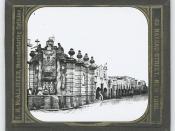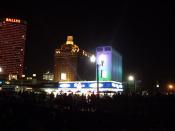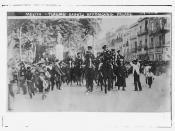The film I chose for analysis is Once Upon a Time in Mexico. I viewed this film on November 17, 2003 at the Channel Islands Theater in Oxnard. The structural effect I am critiquing is the dynamic editing effect. This film is full of very fast paced action scenes throughout the entire film. To really understand and keep up, one must have a good analytical mind because there are several story lines that blend in together at the end.
Robert Rodriguez has impressed me so much that I must comment on him. He is an amazing and talented man. He was not only the director this film, he was also the writer, producer and editor plus the credit state he chopped, shot and scored Once Upon a Time in Mexico. He personally operated the video camera and the new Sony 24-fps digital Hi-Def camera, so he knew the precise effect he was searching for.
Before shooting the scenes he storyboards some of them in a cartoon fashion, then shoots them on video before filming the actual scenes. He implements the most up-to-date technology in his films. In Once Upon a Time in Mexico, he used the Sony digital hi-Def technology camera compositions that include great facial close-ups, making landscapes of the faces and the classical western shoot-outs. His action sequences create humor and are also a salute to the old Sergio Leone westerns. This film included Dolby digital, Sony digital dynamic sound and Dolby stereo. He made violence in the film choreographic. The Rodriguez epic is more fascinated in the moment, in great shots, in surprises and ironic reversals and close-ups of sweaty faces then in a rational story. The film feeds on the music of heroism and sorrow. This story is in bold, vivid colors. He goes for sensational...


